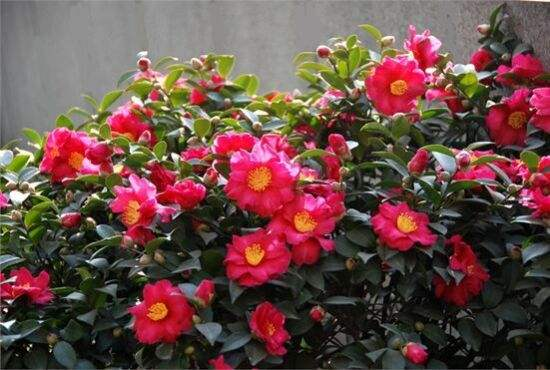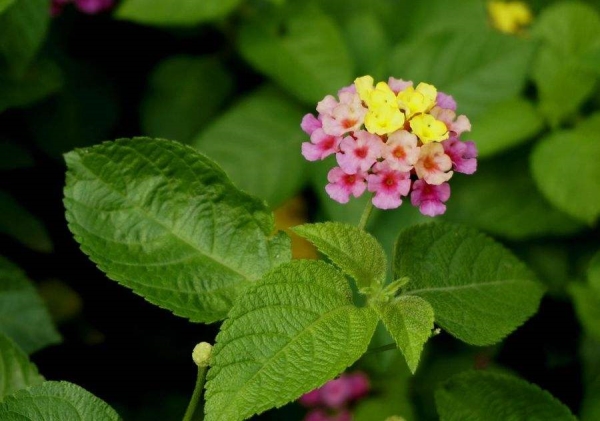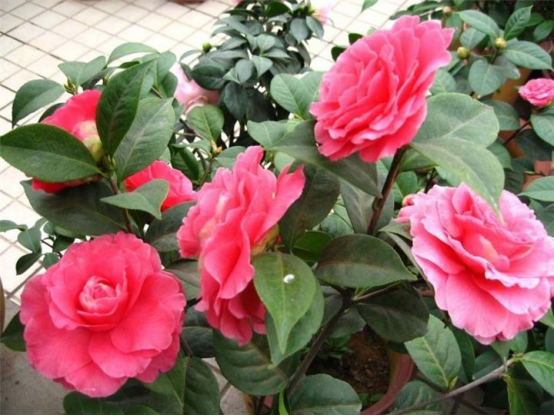What are the advantages of making bonsai with tea plum:
Tea plum tree is relatively small, its branches are also relatively low, it is easy to trim shape, tea plum bonsai is also born. Tea plum tree shape is very beautiful, the leaves are very elegant, and the flowers are very gorgeous, and the flowering period can be from November of that year to March of the following year, so making bonsai is of high ornamental value.

Chinese Bonsai School-- Lingnan Bonsai School
China has a vast territory, due to the differences in regional environment and natural conditions, there are many bonsai schools, especially since the reform and opening up, the traditional schools have further developed, and new schools continue to emerge, forming a good situation of a hundred flowers competing in beauty. As far as the five traditional schools are concerned, they are divided into the South School and the North School. The South School is represented by Guangzhou, and the North School includes the Sichuan School, Yang School, Su School and Shanghai School in the Yangtze River Basin. China's bonsai art schools have a long history, colorful, due to the differences in specific conditions, the development is very uneven, huge as a vast river, details like a trickle Qingxi, each has its own style, each has its own personality, competing for wonder and beauty, Baihui unexpectedly opened. In addition to the previous five major schools, some other schools, in the new historical period, also take advantage of the east wind of reform and opening up to compete with Sichuan, Yang, the Soviet Union, Shanghai, and Lingnan, thus creating an unprecedented prosperity of bonsai art! Guangdong bonsai centered on "Flower City" Guangzhou is called Lingnan School because it is located in the south of Wuling. The warm climate, abundant sunshine, abundant Rain Water, moist vegetation and unique natural environment provide extremely favorable conditions for the prosperity of bonsai art. Although Lingnan bonsai art started relatively late, it also has a history of hundreds of years. In the Qing Dynasty, Guangdong was recorded in detail in his book Guangdong Xinyu by qu Dajun, a famous poet. However, the bonsai art style of Lingnan School was really formed after the 1930s. The traditional Guangdong bonsai is similar to the "swimming dragon bend" style of the northern school, with the trunk standing upright with its left and right arms hanging horizontally, making five or seven supports, and the top of the tree is flat, which is called "ancient tree" or "general tree." this kind of bonsai takes a lot of effort and time. It usually takes 30 or 40 years to take shape. By the end of the last century, with the change of society and the development of culture and art, especially under the influence of the Lingnan School of painting, some Guangdong painters were not only good at painting, but also loved bonsai, and made bold reforms in modeling, based on the meaning of painting. gradually expand the range of tree species and become the prototype of Lingnan bonsai. Since the 1930s, Guangdong bonsai has been divided into three schools: first, a school headed by bonsai artist Kong Taichu, with vigorous tree shape, dense canopy, rigorous composition, showing the grace of wild ancient trees; second, a school headed by Taoist monks of the Sanyuan Palace in Guangzhou, mainly using dying tree stumps as materials, after careful cultivation, to grow new buds from a certain part, with chic and fluency as the most precious Third, the school headed by the Suren monk of Haizhu Temple in Guangzhou, supporting and standing tall and straight, standing in the sky, although the technical support is few but does not feel empty, implicit and concise, elegant and natural, there is a little bit of Zheng Banqiao "redundant and complicated to stay thin", "one branch and one leaf" poetic. After the founding of New China, the Guangzhou Bonsai Association, under the technical guidance of Kong Taichu, took Xiyuan as the research base, gathered the advantages of the three schools and integrated them into a complete and unique Lingnan school, which made the artistic modeling of Lingnan bonsai more unpredictable and varied. Such as Xiumao Xiongqi tree type, tall and straight towering type, wild natural type, dry and short leaves dense foliage type, and so on, the general artistic motto can be summarized into eight words: vigorous and vigorous, smooth and natural. Kong Taichu, one of the founders of Lingnan style, has devoted himself to the cause of bonsai art since the age of 19, pioneering the method of "storing skills and cutting dry". Intensity cutting At the same time, the second branch (or bud) with suitable angle and position is selected, and when the second section reaches the required thickness, it will be cut again, and the following sections 3 and 4 will be cut. It's all done this way. Generally, there are about two small skills (or buds) on each branch, one long and one short. After many years of pruning, the proportion of the branches is symmetrical, tortuous and powerful, and its branch supports are "like antlers and drooping chicken feet". There are jumping branches, floating branches and spreading branches, and the claws of the second, third and fourth layers of each branch support are required to be gradually thinned and evenly distributed. The branch support (equivalent to the branch plate, cloud piece and branch piece of the North School) is the basic technique of Lingnan school modeling, which has high aesthetic value. Spring, summer, autumn and winter, the four seasons are rewarded: spring sprouting, new green spots dyed; summer rich, green cover overlapping; autumn Frosts Descent, yellow leaves are beautiful; winter weather is cold, horn claws glow. Sometimes in order to enjoy the beauty of the horns and claws of the branches, the leaves are deliberately removed, which is called "undressing for brocade". This is an artistic effect that other bonsai schools are difficult to achieve. Although the landscape bonsai is not the specialty of the Lingnan School, it also has considerable achievements, mainly showing the beautiful natural scenery of the South, including dangerous rocks, high gorges and deep valleys, rich in Lingnan painting style. Commonly used stone materials are Yingde stone, sand stone, Reed stone, pumice, seaweed stone (coral stone), stalactite and so on. Tree stump bonsai commonly used tree species are: Jiuli incense, Fujian tea, elm, sparrow plum. Banyan, yellow poplar, Luo Han Song, five needle pine, rhododendron, water mast, plum, ginkgo and so on.
Chinese bonsai school-Lingnan school bonsai-
China has a vast territory, due to the differences in regional environment and natural conditions, there are many bonsai schools, especially since the reform and opening up, the traditional schools have further developed, and new schools continue to emerge, forming a good situation of a hundred flowers competing in beauty. As far as the five traditional schools are concerned, they are divided into the South School and the North School. The South School is represented by Guangzhou, and the North School includes the Sichuan School, Yang School, Su School and Shanghai School in the Yangtze River Basin. China's bonsai art schools have a long history, colorful, due to the differences in specific conditions, the development is very uneven, huge as a vast river, details like a trickle Qingxi, each has its own style, each has its own personality, competing for wonder and beauty, Baihui unexpectedly opened. In addition to the previous five major schools, some other schools, in the new historical period, also take advantage of the east wind of reform and opening up to compete with Sichuan, Yang, the Soviet Union, Shanghai, and Lingnan, thus creating an unprecedented prosperity of bonsai art! Guangdong bonsai centered on "Flower City" Guangzhou is called Lingnan School because it is located in the south of Wuling. The warm climate, abundant sunshine, abundant Rain Water, moist vegetation and unique natural environment provide extremely favorable conditions for the prosperity of bonsai art. Although Lingnan bonsai art started relatively late, it also has a history of hundreds of years. In the Qing Dynasty, Guangdong was recorded in detail in his book Guangdong Xinyu by qu Dajun, a famous poet. However, the bonsai art style of Lingnan School was really formed after the 1930s. The traditional Guangdong bonsai is similar to the "swimming dragon bend" style of the northern school, with the trunk standing upright with its left and right arms hanging horizontally, making five or seven supports, and the top of the tree is flat, which is called "ancient tree" or "general tree." this kind of bonsai takes a lot of effort and time. It usually takes 30 or 40 years to take shape. By the end of the last century, with the change of society and the development of culture and art, especially under the influence of the Lingnan School of painting, some Guangdong painters were not only good at painting, but also loved bonsai, and made bold reforms in modeling, based on the meaning of painting. gradually expand the range of tree species and become the prototype of Lingnan bonsai. Since the 1930s, Guangdong bonsai has been divided into three schools: first, a school headed by bonsai artist Kong Taichu, with vigorous tree shape, dense canopy, rigorous composition, showing the grace of wild ancient trees; second, a school headed by Taoist monks of the Sanyuan Palace in Guangzhou, mainly using dying tree stumps as materials, after careful cultivation, to grow new buds from a certain part, with chic and fluency as the most precious Third, the school headed by the Suren monk of Haizhu Temple in Guangzhou, supporting and standing tall and straight, standing in the sky, although the technical support is few but does not feel empty, implicit and concise, elegant and natural, there is a little bit of Zheng Banqiao "redundant and complicated to stay thin", "one branch and one leaf" poetic. After the founding of New China, the Guangzhou Bonsai Association, under the technical guidance of Kong Taichu, took Xiyuan as the research base, gathered the advantages of the three schools and integrated them into a complete and unique Lingnan school, which made the artistic modeling of Lingnan bonsai more unpredictable and varied. Such as Xiumao Xiongqi tree type, tall and straight towering type, wild natural type, dry and short leaves dense foliage type, and so on, the general artistic motto can be summarized into eight words: vigorous and vigorous, smooth and natural. Kong Taichu, one of the founders of Lingnan style, has devoted himself to the cause of bonsai art since the age of 19, pioneering the method of "storing skills and cutting dry". Intensity cutting At the same time, the second branch (or bud) with suitable angle and position is selected, and when the second section reaches the required thickness, it will be cut again, and the following sections 3 and 4 will be cut. It's all done this way. Generally, there are about two small skills (or buds) on each branch, one long and one short. After many years of pruning, the proportion of the branches is symmetrical, tortuous and powerful, and its branch supports are "like antlers and drooping chicken feet". There are jumping branches, floating branches and spreading branches, and the claws of the second, third and fourth layers of each branch support are required to be gradually thinned and evenly distributed. The branch support (equivalent to the branch plate, cloud piece and branch piece of the North School) is the basic technique of Lingnan school modeling, which has high aesthetic value. Spring, summer, autumn and winter, the four seasons are rewarded: spring sprouting, new green spots dyed; summer rich, green cover overlapping; autumn Frosts Descent, yellow leaves are beautiful; winter weather is cold, horn claws glow. Sometimes in order to enjoy the beauty of the horns and claws of the branches, the leaves are deliberately removed, which is called "undressing for brocade". This is an artistic effect that other bonsai schools are difficult to achieve.
Although the landscape bonsai is not the specialty of the Lingnan School, it also has considerable achievements, mainly showing the beautiful natural scenery of the South, including dangerous rocks, high gorges and deep valleys, rich in Lingnan painting style. Commonly used stone materials are Yingde stone, sand stone, Reed stone, pumice, seaweed stone (coral stone), stalactite and so on.
Tree stump bonsai commonly used tree species are: Jiuli incense, Fujian tea, elm, sparrow plum. Banyan, yellow poplar, Luo Han Song, five needle pine, rhododendron, water mast, plum, ginkgo and so on.
- Prev

Matters needing attention in culturing five-colored plum
Five-colored plum loves the sun, so it is best to keep no less than five hours of light every day, which will help it blossom and grow better. And it likes to grow in a warm and humid climate, this species is a tropical plant, like high temperature and humidity, but also resistant to dry and hot, cold resistance is poor, it should be placed in indoor maintenance in winter
- Next

I. maintenance methods of tea plum bonsai
1. Sunny tea plum likes yin and dampness, and half-yin and half-yang is the most suitable. Strong summer light may burn its leaves and buds, causing the leaves to fall off. But it also needs proper light in order to bloom luxuriantly and brightly. two。 The soil is suitable for growing in acid sandy soil with loose fertility and good drainage.
Related
- Fuxing push coffee new agricultural production and marketing class: lack of small-scale processing plants
- Jujube rice field leisure farm deep ploughing Yilan for five years to create a space for organic food and play
- Nongyu Farm-A trial of organic papaya for brave women with advanced technology
- Four points for attention in the prevention and control of diseases and insect pests of edible fungi
- How to add nutrient solution to Edible Fungi
- Is there any good way to control edible fungus mites?
- Open Inoculation Technology of Edible Fungi
- Is there any clever way to use fertilizer for edible fungus in winter?
- What agents are used to kill the pathogens of edible fungi in the mushroom shed?
- Rapid drying of Edible Fungi

